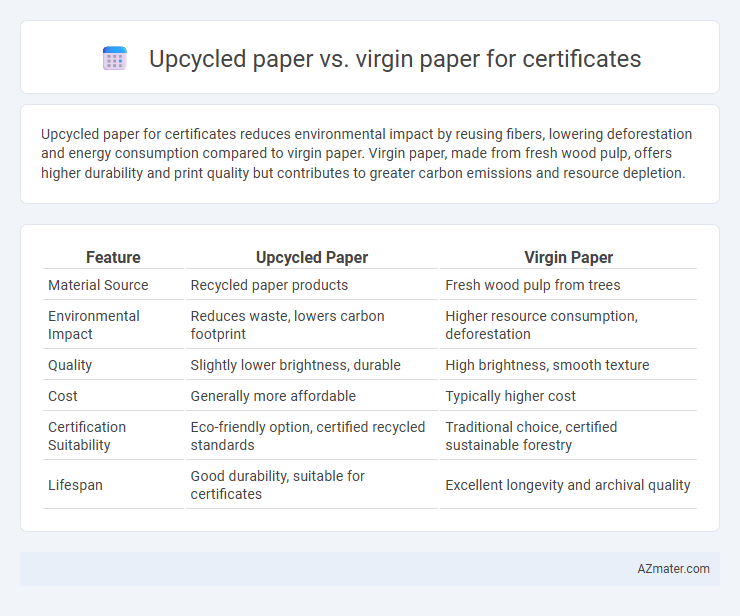Upcycled paper for certificates reduces environmental impact by reusing fibers, lowering deforestation and energy consumption compared to virgin paper. Virgin paper, made from fresh wood pulp, offers higher durability and print quality but contributes to greater carbon emissions and resource depletion.
Table of Comparison
| Feature | Upcycled Paper | Virgin Paper |
|---|---|---|
| Material Source | Recycled paper products | Fresh wood pulp from trees |
| Environmental Impact | Reduces waste, lowers carbon footprint | Higher resource consumption, deforestation |
| Quality | Slightly lower brightness, durable | High brightness, smooth texture |
| Cost | Generally more affordable | Typically higher cost |
| Certification Suitability | Eco-friendly option, certified recycled standards | Traditional choice, certified sustainable forestry |
| Lifespan | Good durability, suitable for certificates | Excellent longevity and archival quality |
Introduction to Certificate Paper Choices
Certificate paper choices often include upcycled paper and virgin paper, each offering distinct environmental and quality benefits. Upcycled paper utilizes recycled fibers, reducing deforestation and lowering carbon emissions, making it an eco-friendly option for certificates. Virgin paper provides a smoother texture and higher durability, preferred for formal documents requiring long-term preservation and vibrant print quality.
What is Upcycled Paper?
Upcycled paper for certificates is produced by repurposing waste paper materials, reducing the need for virgin pulp and minimizing environmental impact. This paper retains quality and durability while incorporating recycled fibers, making it an eco-friendly alternative to traditional virgin paper made from freshly harvested trees. Using upcycled paper supports sustainable practices by conserving natural resources and lowering carbon emissions during production.
What is Virgin Paper?
Virgin paper is made directly from fresh wood pulp, harvested specifically for paper production, ensuring high fiber strength and purity. It offers superior print quality and durability, making it ideal for certificates that require a professional appearance and long-lasting preservation. Compared to upcycled paper, virgin paper typically involves more resource-intensive processes with higher environmental impact due to deforestation and energy consumption.
Environmental Impact: Upcycled vs Virgin Paper
Upcycled paper for certificates significantly reduces environmental impact by repurposing waste materials, lowering energy consumption, and decreasing landfill waste compared to virgin paper, which requires fresh timber and intensive processing. The production of virgin paper contributes to deforestation, higher greenhouse gas emissions, and greater water usage, intensifying ecological disruption. Choosing upcycled paper supports sustainability by minimizing resource depletion and promoting circular economy principles in paper manufacturing.
Cost Comparison: Upcycled vs Virgin Paper
Upcycled paper for certificates generally offers a lower cost compared to virgin paper due to reduced raw material and processing expenses. Virgin paper production requires fresh pulp, increasing manufacturing costs and environmental impact. Choosing upcycled paper can result in significant savings while supporting sustainable practices without compromising certificate quality.
Quality and Durability for Certificates
Upcycled paper for certificates offers a sustainable option but may exhibit slightly lower fiber strength and less uniform texture compared to virgin paper, which is derived from fresh pulp with high-quality fibers ensuring superior durability. Virgin paper typically provides enhanced resistance to wear and tear, maintaining the certificate's crisp appearance over time, critical for official documents requiring longevity. The choice between upcycled and virgin paper should weigh the trade-off between environmental benefits and the demand for premium quality and durability in certificate presentation.
Aesthetic Differences in Certificate Presentation
Upcycled paper offers a distinct textured surface and natural, uneven color variations, enhancing the artisanal appeal of certificates. Virgin paper provides a smoother, uniform finish that creates a polished and professional look preferred for formal presentations. The choice between the two affects the certificate's tactile experience and visual impression, with upcycled paper emphasizing sustainability and uniqueness, while virgin paper emphasizes clarity and refinement.
Certification and Authenticity Concerns
Upcycled paper certificates often feature certifications such as FSC Recycled or SFI Recycled, ensuring environmental stewardship and responsible sourcing, while virgin paper certificates typically hold certifications like FSC or PEFC, indicating integrity and sustainable forestry practices. Authenticity concerns for certificates hinge on paper quality and security features rather than fiber origin, making certified virgin and upcycled papers equally viable for formal documents. Institutions prioritizing credible certification marks and security elements can effectively use upcycled paper without compromising the certificate's authenticity or official status.
Consumer Perception and Branding
Upcycled paper for certificates is increasingly favored by eco-conscious consumers who associate it with sustainability and corporate responsibility, enhancing brand image and customer loyalty. Virgin paper, perceived as higher quality and more durable, often conveys prestige and formality, appealing to traditional and luxury markets. Brands prioritizing environmental values leverage upcycled paper to differentiate themselves and align with green marketing strategies, while those seeking classic recognition frequently opt for virgin paper to maintain a premium aesthetic.
Making the Sustainable Choice for Certificates
Upcycled paper for certificates reduces forest depletion by reusing fibers, significantly lowering carbon emissions compared to virgin paper production, which relies on fresh wood pulp and extensive water consumption. Choosing upcycled paper supports circular economy principles, minimizes landfill waste, and often incorporates post-consumer content that maintains durability and print quality suitable for formal documents. This sustainable option aligns with environmental certification standards, making it a responsible choice for organizations prioritizing eco-friendly credentials in their official paperwork.

Infographic: Upcycled paper vs Virgin paper for Certificate
 azmater.com
azmater.com